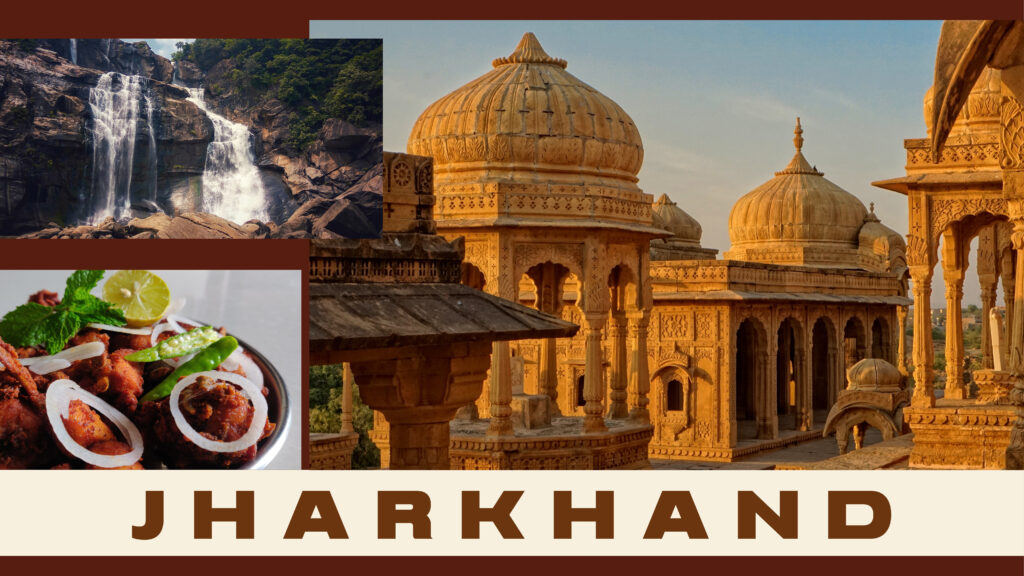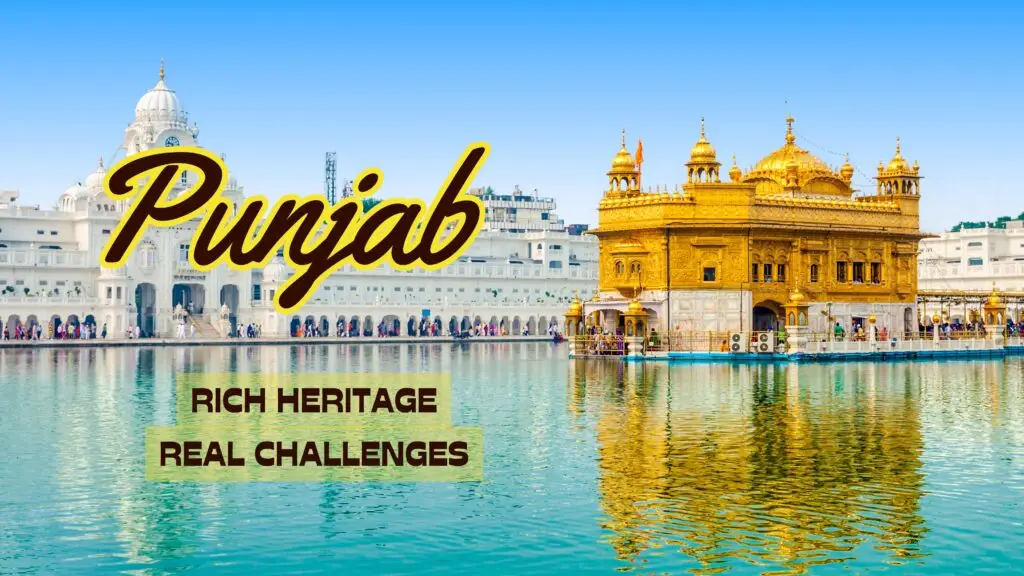Located in the eastern region of the entire Indian land, Jharkhand is the state that represents the insatiable forces of nature as well as the settled nature of the population of the local tribes. Constitutionally, its name, translated as “The Land of Forests” metaphorically means that it is home to some of the most stunning waterfalls, abundance of forest cover and mineral resources which have made it an industrial powerhouse. In addition to its natural-industrial wealth, Jharkhand has a rich tribal heritage whose lifestyles have continued to be closely linked to the land.
The state of Jharkhand is more than the geographical state, it is the story of resilience, an ancient kin, and a story of a people trying to live and make it their own. We invite you to take this trip of discovery to get to know this unique state with a fascinating history, deep rooted cultural heritage coupled with beautiful geography and the road to a robust future that is diverse and inclusive.

Jharkhand’s Fight for Identity
A deep and detailed history of Jharkhand is an interesting story of strong tribal people and their fight to conserve their land, culture and lifestyle. Several tribes, such as the Santhals, Mundas, Oraons, and Hos, inhabited the region and had local self-rule communities that tended to resist all forms of alien authority.
- Pre-Independence: The ethnic groups strongly opposed colonial hegemony as well as landlords. The British faced several uprisings, including the Santhal Rebellion of 1855-56 and the Birsa Munda-led Ulgulan (Great Tumult) in the late 19th century. These movements, which were under the leadership of some famous personalities, preconditioned the emergence of a separate identity and the need to have a separate state.
- The Fight over Statehood: States like Jharkhand began demanding their own state based on ethnic and cultural lines that had acquired increased strength after India got its independence. The movement was the culmination of years of resistance and a wish to gain self government in order to defend tribal levels of rights, resources, and customs.
- Creation of Jharkhand: Jharkhand which was a part of a southern Bihar became the 28th state of Indian Union after a prolonged and hard-fought battle on November 15, 2000. This is also the birthday of Birsa Munda, a much-beloved tribal freedom fighter.
This historical experience of a hard-earned struggle to achieve statehood has instilled a strong sense of pride in the people of Jharkhand, and a strong commitment without which the cultural heritage and the identity of this state cannot be recovered nor reclaimed.
Jharkhand’s Rich Traditions
The culture of the state of Jharkhand is a rich representation of blending of various tribal, and non-tribal tribes that include Santhals, Mundas and Oraons to name a few whose culture, language, and festivals have added their individual hues to it.
- Tribal Languages: Tribal languages are Santhali, Mundari, Ho and Kurukh and so on. Hindi, Angika are also popular.
- Festivals: Festivals are closely related to nature and the agricultural cycle.
- Sarhul: The tribal main festival it celebrates new year and the arrival of spring. It is observed through procession, singing and dancing.
- Karma: a great festival in appreciation of good luck and a good harvest.
- Sohrai: The harvest festival is held once after paddy crop has been harvested.
- Baha Parva (Flower Festival): Celebrates the blooming of the Sal flowers.
- Arts & Crafts: Jharkhand is famous place because of its out-of-this-world handicrafts which is an important part of everyday life.
- Paitkar Painting: A type of scroll painting of antiquity.
- Dokra Art: It is a metal casting art form.
- Terracotta Crafts: Terracotta in form of beautiful terracotta pottery and terracotta figurines.
- Tribal Jewelry: Jewelry which is made of beads and brass among others.
- Bamboo/Cane work: Bamboo and cane are fashioned to make gorgeous baskets, furniture, and the traditional drinking mugs.
- Music & Dance: Folk dances are vibrant and rhythmic, often accompanied by drums (Mandar) and other traditional instruments. The stories, mostly about nature, agriculture and love, are chorus like and possess a strong flavor.
Nature’s Untouched Beauty
Jharkhand is an abode of awe-inspiring natural beauty in huge percentages of forests, hilly terrains, waterfalls.
- Forests: The state is appropriately termed as the state of forests as so much of its real estate cover is on Sal, Teak and other valuable trees. The highlands consist of forests that house a great number of flora and fauna.
- Waterfalls: Hundru Falls, Jonha Falls and Dassam Falls are some other popular waterfalls of the state that are also a big tourist attraction.
- Wildlife Sanctuaries: Some of the wildlife sanctuaries in the state are Hazaribagh National Park, Purulia Wildlife Sanctuary, Palamau Tiger Reserve which is one of the earliest tiger reserves in India.
- Mineral Wealth: Jharkhand is a mineral rich state of India. It is a substantial producer of coal, iron ore, copper, bauxite and mica. This mineral deposit has caused it to be a centre of heavy industries.
No change has taken place without bringing some challenges to the state`s natural environment. The big problem is deforestation caused by logging, mining, and increase in population. Several local authorities are collaborating with the government to enhance the process of afforestation, sustainable mining exploration and conservation in order to preserve the delicate environment that exists in the state.
A Growing Economy and Development
The economy of Jharkhand is a combination of traditional farming and an industrial sector with mineral based industries.
- Agriculture: Most of the rural citizens depend on farming. The major crop grown in the state is rice followed by maize, pulse, and oilseeds. The government is encouraging the new methods of farming and irrigation projects to increase the products.
- Mining and Industry: It is the most crucial part of the economy of the state. Jharkhand is home to some of India’s largest steel plants (Tata Steel in Jamshedpur) and coal mines (Dhanbad). The presence of minerals has enabled big investments by both the public and the private sector in the state.
- Handicrafts and Handlooms: Handicrafts and Handlooms occupations of many tribal people are the major source of their livelihood.
- Tourism: Tourism is an emerging phenomenon in the state with natural attractiveness and great cultural heritage making it an attraction to tourists.
- IT and Startups: Cities like Ranchi are developing as hubs of IT and startups which the government is supporting so that even after minerals the economy can diversify.
The state government is making a sustained investment in the infrastructure and is encouraging development of skills and creating business friendly atmosphere to attract more investment and generate lawful employment opportunities to the large number of youthful population.
The Land of Warmth
The hospitality of Jharkhand is very simple, yet it is quite warm and sincere representing the rural and tribal nature of its population. The state has a genuine and non-touristic form of tourism.
- Ranchi: the capital, often referred to as the “City of Waterfall(s)”, with such sights as the Hundru Falls, Jonha Falls and the gorgeous Ranchi Lake.
- Jamshedpur: well planned industrial city, nick-named as the steel city of India with picturesque parks and neat environs.
- Betla National Park: This is a big wildlife sanctuary and a great place to make safari in the Palamau district.
- Deoghar: One of the biggest pilgrimage sites, Deoghar is the place containing Baba Baidyanath Temple, one of the twelve Jyotirlingas.
- Hazaribagh: A place with a famous national park and photography.
- Tribal Villages: Tribal villages are a great cultural experience where you get to learn about their lives, their methods of farming and living the way they do.
Challenges and The Road Ahead
Much as it is a rich mineral state with a fair number of mineral deposits, Jharkhand still suffers some of the problems:
- Poverty and Inequality: As much as it has been endowed with mineral wealth, a significant population, especially the tribal communities, live in poverty.
- Political and Social Instability: there is a history of political instability and land rights as well as tribal displacement by mining and industrial undertakings.
- Infrastructure Weaknesses: A low degree of road connectivity (in particular, to remote areas) and infrequent rail and air connectivity are the biggest obstacles.
- Deforestation and environmental degradation: Deforestation and environmental degradation are characterized by unregulated mining and exploitation activities.
Yet, Jharkhand is one State that is making a positive difference in mapping a brighter globally inclusive future. The government is giving attention to:
- Inclusive Growth: Making sure that the advances of industrialization and the benefits extend to every strata of the society and in particular to the tribal communities.
- Sustainable Development: We encourage sustainable mining activities, planting of trees and environmental conservation.
- Infrastructure Up-Gradation: Putting lot of money on roads, power and the digital connection.
- Skill Development: This ensures that the youth get skills to cope with the new economy and lower unemployment rates.
The Singular Will of Jharkhand
Jharkhand has emerged as the state of raw beauty. It is the land of unbelievable natural beauties, rich traditions and people with the unbreakable spirit. With a vision in hand, the state is on the move as it is testament to how even a land that has on its past ancient struggles can be made up of a future of peace, prosperity, and features limitless possibilities.




